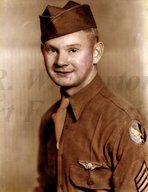
|

|
|
|
|
"We had the bare necessities, like maybe a couple changes of clothes, plain food," he recalls of his boyhood. Edward was born in Hodge, Louisiana, and grew up near Quitman on "a kind of scrubby little farm," he says. He graduated from Quitman High School in 1941, attended Louisiana Tech for two semesters, and then trade school in Winfield where he learned sheet metal work on airplanes. Edward joined the U.S. Army Air Forces on October 28, 1942. Trained as a ball turret gunner on a B-24, he was attached to the 765th Squadron, 461st Bombardment Group, Fifteenth Air Force. His pilot's name was Walter J. Grimm. "We called our crew `Grimm's Gremlins,'" he says. He was sent to Toretta Air Base, built in a wheat field near Cerignola, Italy in February of 1944. From there he flew fifty missions. For a typical mission, he was awakened at 2:45 a.m., ate breakfast of powdered eggs and Spam at 3 a.m., and reported to the briefing room by 4 a.m. While awaiting the briefing, they listened to "Axis Sally," the radio propagandist. "She had good American music. We listened to her until briefing time, and sometimes she'd tell us where we were going. The Germans had very good intelligence," he recalls. He says the temperatures in a ball turret would plummet to thirty-five or forty below. "As long as your feet and hands were hurting you were all right. But if they quit hurting you were in trouble. You had frostbite," he says. They hit targets in France and southern Germany, and pounded oil refineries in Ploesti, Rumania several times. He says his last few missions were the most stressful. His final mission, on September 1, 1944, "was one of the happiest days of my life, and it was a milk run at that," he says. The combat took a toll on his health. He weighed 165 when he reached Italy, and 130 when he left. Edward returned to America in the fall of 1944 and taught B-24 hydraulics at Chanute Field in Chicago. He was discharged at Camp Shelby near Hattiesburg, Mississippi on October 28, 1945. After the war, Edward finished his four-year engineering degree program at Louisiana Tech in three years. He worked at Rothschild Boiler and Tank as chief engineer and vice president of engineering for thirty-one years. |


